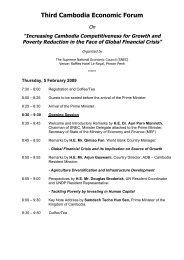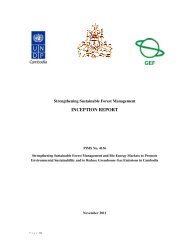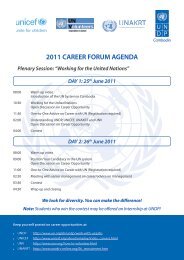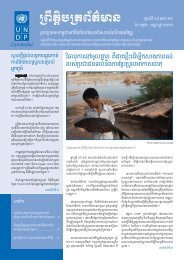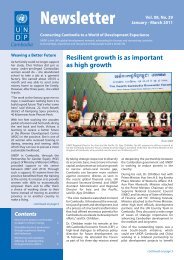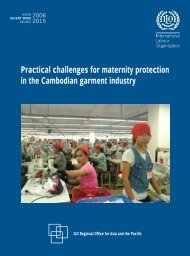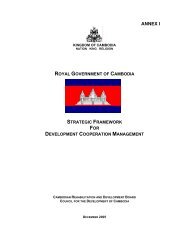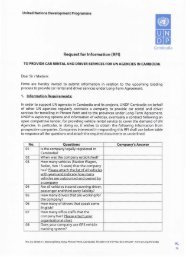Kreung Ethnicity - United Nations in Cambodia
Kreung Ethnicity - United Nations in Cambodia
Kreung Ethnicity - United Nations in Cambodia
You also want an ePaper? Increase the reach of your titles
YUMPU automatically turns print PDFs into web optimized ePapers that Google loves.
Due to the fact that one convicted of murder will be condemned by the court<br />
and put <strong>in</strong> jail, villagers will not force the murderer to pay the entire tatch<br />
accord<strong>in</strong>g to tradition. Instead s/he must pay half the tatch which is the<br />
equivalent of six buffaloes. If the murderer cannot afford the required number<br />
of buffaloes, his family (extend<strong>in</strong>g as far as his/her second cous<strong>in</strong>) may pay the<br />
rema<strong>in</strong><strong>in</strong>g ‘debt’ accord<strong>in</strong>g to their resources; other villagers may contribute as<br />
well. However, relatives cannot be forced to pay nor have resources confiscated<br />
<strong>in</strong> such situations. Their contribution rema<strong>in</strong>s simply a symbol of charity to either<br />
the perpetrator or the victim.<br />
Tatch <strong>in</strong> such cases is divided <strong>in</strong>to two parts. The first part <strong>in</strong>cludes one buffalo,<br />
one pig, one chicken and a jar of w<strong>in</strong>e for the funeral ceremony. This ceremony<br />
<strong>in</strong>cludes a sacrifice to the spirits to ask for forgiveness, be cleansed of bad luck<br />
and ga<strong>in</strong> future happ<strong>in</strong>ess and fortune. <strong>Kreung</strong> people call this ceremony<br />
Char Brieng (see details <strong>in</strong> section 4.7.2). Other villagers br<strong>in</strong>g their own jars of<br />
w<strong>in</strong>e as a contribution to the ceremony. The second part of the tatch, given to<br />
the victim’s family, is called the pakkahteung 8 mean<strong>in</strong>g the compensation for<br />
the loss of the victim to their family members.<br />
4.1.2 Manslaughter 9<br />
Villagers expla<strong>in</strong>ed that manslaughter is when a perpetrator kills someone,<br />
however, had not planned to kill, i.e. the kill<strong>in</strong>g was accidental, or the perpetrator<br />
was unaware that the <strong>in</strong>jury caused would lead to death. Accord<strong>in</strong>g to the culture<br />
of the villagers, manslaughter does entitle the victim’s family to tatch from the<br />
perpetrator. Manslaughter is not considered to be as serious a crime as<br />
<strong>in</strong>tentional murder as there was no <strong>in</strong>tent to kill the victim. Elders usually settle<br />
such cases by order<strong>in</strong>g the perpetrator to compensate the victim’s family with<br />
assets equal to six buffaloes. However, the tatch is negotiable <strong>in</strong> accordance with<br />
the agreement between both parties.<br />
8<br />
This word is from the orig<strong>in</strong>al <strong>Kreung</strong> and usage is used throughout this document.<br />
9<br />
Accord<strong>in</strong>g to the Crim<strong>in</strong>al Code Article 207, manslaughter is punishable with a sentence of one to three<br />
years <strong>in</strong> jail and a f<strong>in</strong>e of 2-6,000,000 riel.<br />
<strong>Kreung</strong> <strong>Ethnicity</strong>: Documentation of Customary Rules<br />
15




